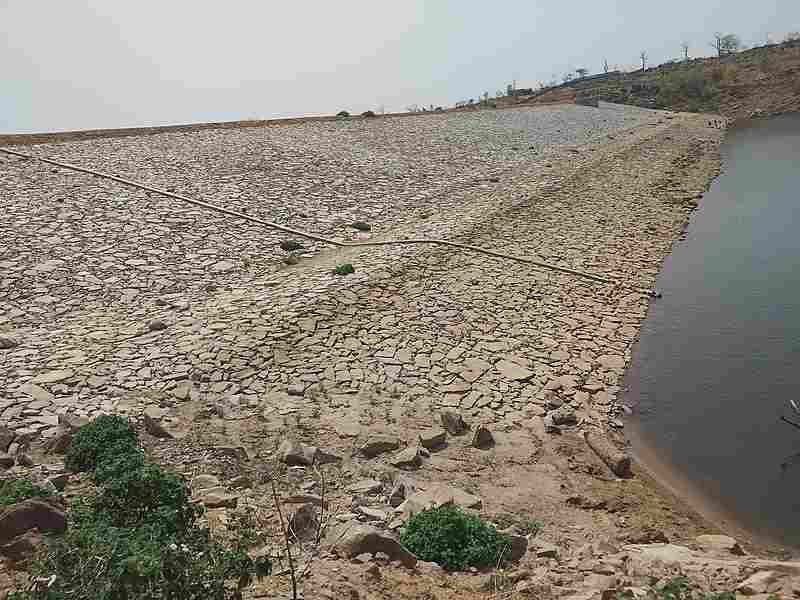9 Solutions to Soil Erosion and Their Mechanisms, Benefits
Solutions to soil erosion include; dam construction, afforestation, mulching, cover crop planting, terracing, embankment-flow diversions, sustainable irrigation, crushed rocks for soil stabilization, and conservation tillage.
This article discusses the solutions to soil erosion, as follows;
1). Dam Construction: One of the Solutions to Soil Erosion
Dam construction is an effective solution to mitigate soil erosion risks, especially due to its ability to provide a form of water conservation/storage, and manage the flow of water.
Soil erosion occurs when water carries away sediments and dislodged-soil particles from one location to another. Water dams act as physical barriers to flow, and offer several mechanisms to prevent soil erosion, some of which are highlighted in the following subsection;
Mechanism(s) of Soil Erosion Control by Water Dams
Erosion is controlled by dams through a combination of sediment trapping, water flow regulation, creation of stagnant water zones, and reduced gully formation.
Dams are constructed mainly to store and regulate water flow in rivers or streams. As water flows downstream, it carries sediments and eroded soil particles with it. The dams provide an artificial reservoir where these sediments are trapped and settled before they can be transported further [6]. This mechanism of sediment retention is one of the key pathways that dams employ to reduce soil erosion.
As stated above, dams help regulate the flow of water in streams and rivers. By storing runoff stormwater and gradually releasing it, dams reduce the force and velocity of such large water masses. This controlled water flow minimizes the erosive power of water, as well as the risk of flooding, thereby preventing the water from dislodging and transporting soil particles.
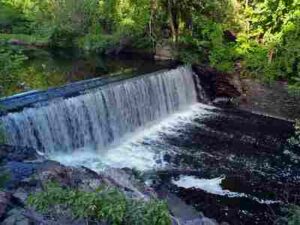
Stagnant water zones are created by dams in upstream areas, where water flows slowly or is at rest. In these zones, the sediments settle out of the water, diminishing the erosive function of the flowing water.
Lastly, dams can block active gullies by diverting water and preventing it from cutting deep channels into the landscape. By controlling the flow of water, dams help to prevent the formation of new gullies, which are common pathways for severe soil erosion.
Benefits of Dam Construction for Soil Erosion Mitigation
Benefits of using dams to mitigate soil erosion include; sediment retention, reduced flow velocity, gully prevention, reservoir creation, and land stabilization.
Generally, dams act as artificial sediment traps, which prevent the transport of soil particles downstream and allow them to settle within the reservoir.
These dams regulate water flow, reducing the velocity and inertia of water, which is an essential step in minimizing soil erosion.
Dams help minimize or prevent the formation of gullies, by regulating water flow and preventing its concentrated movement through certain areas.
The creation of reservoirs for water storage can also serve various purposes, such as providing water for irrigation, recreation, and hydroelectric power generation [1].
Lastly, dams can help stabilize the surrounding land by reducing the erosive effects of water, and promoting the growth of vegetation in these areas.
*Additional Notes and Reiterations on Dams for Soil Erosion Control
Dams prevent soil erosion by trapping sediments in reservoirs and regulating water flow, which reduces water velocity and prevents the formation of gullies, thereby minimizing the erosive effects of water.
A dam for soil erosion is a structure designed to control the flow of water, store runoff, and trap sediments, preventing soil erosion by controlling the movement of water in streams and rivers.
2). Afforestation
Afforestation is the practice of planting trees or establishing forests in areas that were previously devoid of forest cover.
This technique is critical in mitigating soil erosion and usually offers a natural and effective solution.
Mechanism(s) of Soil Erosion Control Through Afforestation
The fundamental mechanisms of afforestation in preventing soil erosion include; root binding, rainwater interception and soil covering.
Trees, particularly mature and well-established ones, usually possess extensive and robust root systems. These roots penetrate deep into the soil and create a network that binds the soil (and rock) particles together.
The roots of trees anchor the soil, thereby preventing it from getting blown away by wind or washed away by flowing water. This form of soil stabilization is one of the most effective mechanisms for reducing erosion. The roots create a physical barrier that holds the soil in place.
Trees also have a canopy layer that intercepts rainwater and reduces the impact of raindrops falling on the soil [2]. By doing so, they prevent soil particles from being dislodged and transported by surface runoff. The growth of trees creates a thick vegetative cover on the land, further protecting the soil from erosion caused by wind and water.
Benefits of Afforestation as a Method of Soil Erosion Control
Benefits of afforestation include reduction of soil erosion, stabilization of soil, conservation of soil quality, protection against landslides, and improved water retention.
Afforestation is highly effective in reducing soil erosion. The extensive root systems and thick vegetative cover created by trees prevent soil particles from being washed away or blown away.
As the preceding sentence implies, soil becomes more stable and less prone to erosion due to the binding action of tree roots. This stability is essential in hilly or sloped areas where soil erosion is a significant concern.
Through its stabilizing effect, afforestation helps conserve the quality of soil. The soil remains intact and fertile, making it viable for agricultural and ecological purposes.
In areas that are prone to hazards like landslides, afforestation can provide a form of natural protection. The stabilizing effect of tree roots helps prevent landslides and other forms of slope failures.
Lastly, trees can improve water retention in the soil, thereby reducing the risk of soil erosion caused by excessive runoff.
In general, afforestation is highly effective in reducing erosion. The extensive root systems and vegetative cover created by trees prevent soil from getting blown or washed away, making afforestation one of the most powerful, natural solutions to soil erosion.
3). Mulching: One of the Solutions to Soil Erosion
Mulching is an effective and environmentally friendly way to combat soil erosion.
This practice involves the application of organic materials such as leaves, bark, and grass clippings, over bare soil or immediately over soil that has been seeded. The mechanism and benefits of mulching in preventing soil erosion are discussed below;
Mechanism of Mulching for Soil Erosion Control
With regards to controlling soul erosion; mulching works by preventing soil particle detachment, reducing flow velocity, retaining moisture, and enhancing plant germination.
Mulch acts as a protective layer that prevents the detachment of soil particles. It creates a physical barrier that keeps the underlying soil intact, thereby preventing it from being dislodged by agents of erosion like water or wind.
The presence of mulch on the soil surface reduces the speed and force of runoff water. Slower runoff velocity in turn decreases the erosive power of water, making it less likely to transport away soil particles.
Mulch also retains moisture in the soil, thereby improving the soil's water supply and absorption capacity. This helps maintain soil moisture levels essential for plant growth and the establishment of protective, vegetative cover.
By reducing soil erosion and improving the absorption of moisture, mulch creates optimal conditions for seed germination. The protective layer of mulch enhances the growth of vegetation, and further reduces the vulnerability of the soil to erosion.
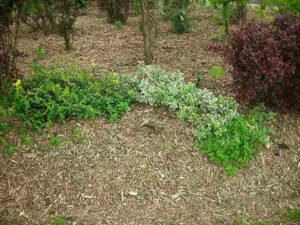
Benefits of Mulching as a Means of Soil Erosion Reduction
In terms of reducing erosion and improving quality, mulching offers benefits like protection of soil particles, moisture retention, soil temperature regulation, and weed suppression.
The primary benefit of mulching is its ability to prevent soil erosion. The physical barrier that is formed by the mulch layer, protects soil particles from detachment, reducing erosion significantly.
Mulch helps the soil retain moisture, and reduces the risk of water-induced erosion, as well as wind erosion in drought-prone regions. By keeping the soil adequately moist, mulching ensures that soil particles are kept in place.
Also, mulch acts as an insulating layer, which regulates soil temperature [7]. It prevents extreme temperature fluctuations that could otherwise affect soil composition, resilience and structure. As stated earlier, mulch can suppress weed growth, further protecting the soil and preventing disturbances that contribute to degradation and erosion.
In general, mulching protects soil from erosion, particularly water and wind erosion. It prevents the detachment of soil particles and reduces runoff velocity, thereby safeguarding the soil from being washed or blown away by natural erosive forces like rain and wind. In addition, mulch helps improve and maintain soil moisture, preventing it from drying out and becoming susceptible to erosion.
4). Cover Crop Planting
Planting cover crops, also known as cover cropping; is an effective strategy to control and prevent soil erosion.
Cover crops are non-commercial crops, that are typically planted during periods when the main cash crop is not growing, such as during the off-season or as an intercrop [3].
Mechanism of Erosion Control Using Cover Crops
The mechanism of erosion control by cover crops consists of; soil surface coverage, root system development, and reduction of flow energy.
Cover crops provide a dense coverage of the soil surface. This coverage in turn functions as a physical barrier, which protects the soil from the impact of raindrops and incoming wind. It reduces the direct contact between soil and erosive forces.
Like forest trees, cover crops have root systems that penetrate deep into the soil profile. These roots help to bind the soil particles together, thereby increasing soil mechanical stability. As they grow, cover crop roots create micro channels within the soil, which improve its structure.
The density of cover crop root systems and the cover provided by the plants, reduce the impactful energy of runoff. When rainwater falls on the soil surface, the cover crops act as physical barriers that slow down the speed of runoff, minimizing its erosive potential.
Benefits of Planting Cover Crops for Soil Erosion Control
Benefits of cover crops as tools for controlling soil erosion include soil stabilization, improved structure, moisture retention, and nutrient management.
Planting cover crops can significantly decrease soil erosion by creating a vegetative layer that shields the soil from both water and wind impacts.
The development of deep-rooted cover crops can enhance soil structure. Root channels created by these crops improve soil aeration and water infiltration, thereby making the soil less susceptible to erosion.
Soil surface coverage by cover crops also aids in retaining soil moisture, and reduces the potential for erosion caused by dry or waterlogged soil conditions.
Lastly, cover crops can scavenge excess nutrients in the soil, reducing nutrient runoff and pollution while fostering the development of healthier soil.
Additional Notes On Erosion Control by Cover Crops
Cover crops control erosion by providing a protective layer that covers the soil surface. This coverage shields the soil from the erosive impact of raindrops and wind.
Also, the development of deep root systems by cover crops improves soil structure and stability, reducing the vulnerability of the soil to erosion.
Cover crops slow down the speed of runoff, decreasing its energy and erosive potential, which makes them effective in controlling soil erosion.
5). Terracing: One of the Solutions to Soil Erosion
Terracing is an effective soil conservation practice that is applied to prevent soil erosion, especially on sloping or hilly land areas [8].
It involves creating a series of flat, elevated platforms called terraces on the landscape to slow down and control the movement of rainwater.
Mechanism of Terracing for Erosion Control
The basic mechanism of terracing for erosion control involves rainwater diversion, and velocity reduction.
Terracing diverts the flow of rainwater, and breaks it into smaller segments as it moves down the slope. This controlled diversion reduces the overall energy of the runoff.
Geometrically, the creation of flat terraces with varying elevations reduces the slope length and angular inclination of the land. This, in turn, significantly reduces the velocity of water flow.
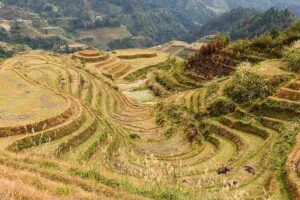
By reducing the speed and volume of rainwater runoff, terracing helps to prevent the accumulation of water and the subsequent erosion of soil. Terraces effectively slow down the movement of runoff while providing suitable conditions for water to be retained and infiltrate the soil.
Benefits of Terracing for Erosion Control
With regards to erosion control, and general soil improvement, terracing offers benefits like; improved fertility, water flow control, reduced sedimentation, water management, and sustainable agricultural yield.
The primary aim of terracing is to improve soil conditions by minimizing leaching and erosion.
By controlling the flow of rainwater and reducing its velocity/energy, terraces are highly effective at minimizing soil loss from sloping lands.
As terracing helps to retain topsoil, it conserves soil fertility. Less erosion means fewer nutrients are carried away by runoff, thereby resulting in healthier and more productive soils.
Terraces also are effective in reducing sedimentation within water bodies downstream. The accumulation of eroded soil particles can be detrimental to aquatic ecosystems. Terracing helps mitigate this ecologic/environmental issue.
Flowing rainwater is collected and slowed down by terraces, which promote its infiltration into the soil. This contributes to improved water management, and reduces the risk of both waterlogging and drought.
Lastly, terracing is vital for sustainable agriculture on hilly or sloping terrain. It is itself a sustainable agricultural practice, which allows for more efficient land use and ensures that soil resources are preserved for future generations.
Additional Notes and Reiterations
Terracing controls soil erosion by reducing the energy of runoff and preventing the accumulation of rainfall on sloping land.
It achieves this by diverting and breaking rainwater into smaller segments, slowing down the water's movement, and promoting water infiltration into the soil. This controlled runoff management effectively minimizes soil erosion.
6). Embankment-Flow Diversions
Embankment-flow diversions are a valuable technique for preventing soil erosion, especially in areas with steep slopes, heavy rainfall, and/or high runoff potential.
These diversions are very instrumental in managing the flow of water, to protect soil from erosion.
Mechanism of Erosion Control by Embankment-Flow Diversion
The mechanism of embankment-flow diversion is based on flow direction alteration, energy dissipation, and stabilization.
Embankment-flow diversions are constructed features that redirect the flow of water, such as rainfall or runoff, away from vulnerable areas. They act as barriers and conduits to guide water in a different direction.
By diverting the flow of stormwater, embankment-flow diversions significantly reduce the energy of the water as it travels downhill. This slower water movement minimizes soil erosion, as the lower energy runoff is less likely to dislodge or transport soil particles.
Embankments can be fortified using materials like rocks, soil, or vegetation. These elements help stabilize the terrain, preventing soil loss due to erosion.
Benefits of Embankment-Flow Diversion
One of the main benefits of embankment-flow diversions is the minimization of soil erosion. Diversion structures effectively redirect the flow of water away from vulnerable slopes and areas, reducing the likelihood of soil displacement.
Fortified embankments protect the topsoil, which is rich in nutrients and crucial for plant growth. This leads to healthier and more fertile soils. Such embankments also reduce the sedimentation of eroded soil particles into nearby water bodies, preserving water quality and productivity of aquatic habitats.
These diversions can help to manage water drainage effectively, preventing waterlogging and optimizing soil health.
Through these various roles, embankment-flow diversions help in mitigating land degradation, and maintaining sustainable land use.
Additional Notes and Reiterations
To prevent embankment erosion, various measures can be taken, such as vegetative covering, riprap technique application, and contour farming.
1. Planting vegetation like grass and shrubs on the embankment can help stabilize the soil and reduce erosion.
2. Installing erosion control materials and structures, like silt fences and geotextiles, can also help protect embankments from erosion.
3. Riprap is a technique that involves placing rocks or stones along the embankment slope to slow and divert flowing water, thereby preventing soil loss.
4. Implementing contour farming techniques can help to manage runoff and erosion on sloped terrain.
To stabilize an embankment, factors required include; proper design, vegetation/revegetation, use of specialized control structures, and maintenance. They are further elaborated in the outline below;
1. Ensure the embankment is designed correctly, considering factors like slope, composite materials, and drainage.
2. Plant native vegetation to reinforce the embankment and improve its stability.
3. Use erosion control structures and materials to safeguard the embankment from erosion and sediment runoff.
4. Regular maintenance is essential to inspect and repair any erosion or damage to the embankment.
Embankment-flow diversion can be an integral part of these stabilization measures, to prevent soil erosion and ensure the long-term stability of embankments.
7). Sustainable Irrigation: One of the Solutions to Soil Erosion
Sustainable irrigation practices are generally critical in preventing soil erosion, ensuring efficient water use, and promoting ecological balance.
Mechanism(s) of Sustainable Irrigation as a Method for Minimizing Soil Erosion
The mechanism of sustainable irrigation for soil erosion prevention comprises of; efficient water delivery, reduction of surface runoff, and topsoil conservation.
Sustainable irrigation methods, such as drip irrigation, supply water directly to the root zones of plants, and deliver only the amount required for optimal growth [5]. This precision in water delivery minimizes excess water, which can lead to leaching and soil erosion.
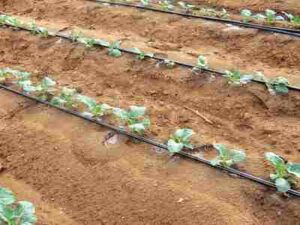
Excessive watering often results in significant surface runoff, which carries away topsoil and causing erosion. On the other hand, sustainable irrigation techniques reduce surface runoff by providing water directly to the roots or plants, thereby preventing soil loss.
By delivering water exactly where it is required and minimizing wastage, sustainable irrigation helps to conserve the topsoil, which is vital for healthy plant growth and soil stability.
Benefits of Sustainable Irrigation for Erosion Mitigation
Benefits of sustainable irrigation include soil and water conservation, nutrient preservation, and improved ecosystem health.
Most sustainable irrigation methods significantly reduce the risk of soil erosion, by preventing excessive water flows and surface runoff. Drip irrigation, in particular, is known to be highly effective in this regard.
Sustainable irrigation ensures that water is used efficiently, thereby reducing wastage and conserving water resources. It helps prevent overwatering, which can lead to soil degradation.
Preventing soil through sustainable irrigation, also safeguards the nutrients present in the topsoil. Unsustainable erosion often leads to nutrient loss, impacting plant health and productivity.
Sustainable irrigation practices minimize runoff into nearby water bodies. This helps to protect water quality by reducing the rate of leaching; of agricultural chemicals like fertilizers, and other contaminants into freshwater sources.
Generally, by preventing soil erosion, sustainable irrigation contributes to overall ecosystem health. It safeguards habitats and maintains the ecological balance of surrounding areas.
Additional Notes: Measures to Ensure Sustainable Irrigation
To ensure sustainable irrigation in the environment, the following measures can be taken;
1. Switching to drip irrigation, as earlier mentioned, is an effective strategy for achieving sustainable irrigation. Drip systems deliver precise amounts of water directly to plant roots without causing soil erosion.
2. Monitor water use to prevent over-irrigation. Implement smart irrigation technologies that adjust water delivery on the basis of on real-time conditions, such as soil moisture and weather.
3. Focus on maintaining healthy soils and crops. Healthy soils can absorb water more effectively, thereby reducing the risk of erosion. Rotating crops and practicing no-till farming can also be helpful.
4. Implement water recycling and reuse systems, which can reduce the overall demand for freshwater resources.
5. Ensure that the water sources for irrigation are managed sustainably, and that they do not deplete local water bodies or harm aquatic ecosystems.
8). Crushed Rocks for Soil Stabilization
Using crushed rocks for soil stabilization is an effective technique to prevent soil erosion, especially in areas that are vulnerable to erosion due to runoff and wind.
This method entails the placement of rocks to provide natural protection to the soil.
Basic Mechanism of Crushed Rock Usage for Erosion Control
The basic mechanism by which crushed rocks help with soil stabilization consists of; physical protection, water diversion, and gravitational settling.
Crushed rocks are used to create a physical barrier that protects soil particles from the erosive forces of water and wind. When properly installed, they lock into place without the need for mortar.
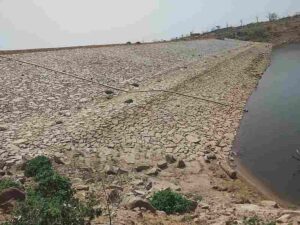
Rocks redirect water flow, especially in areas with heavy runoff, which in turn helps prevent significant surface soil erosion. They obstruct and dissipate currents and wave action, effectively reducing soil displacement.
Crushed rocks are heavy and stable, making them resistant to being washed away by water. They hold their position on riverbanks, shorelines, and steep landscapes, where they provide long-lasting protection.
Benefits of Crushed Rocks for Erosion Control
Crushed rocks as a tool for soil stabilization, are beneficial due to their durability, natural origin, aesthetic appeal, and versatility.
These crushed rocks are particularly effective in controlling soil erosion in high-flow areas, where they prevent displacement of soil by the force of water.
Being durable, crushed rocks provide long-lasting protection, as they resist the erosive impact of both water and wind. They are a low-maintenance solution that can withstand the elements.
Crushed rocks can be integrated into landscapes without altering the natural aesthetics. They blend well with the environment, making them suitable and non-intrusive..
Lastly, crushed rocks can be used in various scenarios, including riverbanks, pond shorelines, sloping landscapes, and even walkways. Their versatility allows for flexible erosion control implementation.
*Additional Notes on Crushed Rocks as Erosion Control Tools
Rocks can be used to prevent erosion by creating physical barriers that protect the soil from the erosive forces of water and wind. They redirect water flow and reduce soil displacement, making them effective in areas prone to erosion.
Irregular-shaped rocks known as riprap are commonly used for preventing soil erosion. These rocks lock into place without the need for mortar and are suitable for shorelines, riverbanks, and other erosion-prone areas.
Various materials can aid in reducing soil erosion, including organic mulches like straw and wood fiber, wood chips, as well as crushed rocks, which can even be incorporated into check dams and terraces in areas with heavy erosion. Vegetation is another option for erosion control, depending on the severity of the erosion problem and local conditions.
9). Conservation Tillage: One of the Solutions to Soil Erosion
Conservation tillage, also known as minimum tillage, is an effective practice aimed at mitigating soil erosion.
It encompasses various techniques like no-till, strip till, ridge till, and mulch till systems, all of which share the common goal of retaining crop residues on a significant portion of the soil surface after tillage activities.
Mechanism of Conservation Tillage for Erosion Control
Conservation tillage emphasizes leaving crop residues from the previous season's crops, on the field surface, to cover at least 30% of it [4]. These residues act as a protective cover (mulch), which shields the soil from erosive forces.
Compared to conventional tillage, conservation tillage minimizes soil disturbance. It involves shallow or no-till practices, which leave the soil structure more intact, and prevent erosion.
Conservation tillage practices can also enhance soil structure by reducing soil bulk density and redistributing soil pore space. This improves soil physical properties and aeration, as well as increasing rainfall infiltration and soil water storage capacity.
Benefits of Conservation Tillage as a Means of Controlling Erosion and Optimizing Soil Conditions
One of the benefits of conservation tillage is its role in the significant reduction in soil erosion. By preserving crop residues and minimizing soil disturbance, it prevents the detachment of soil particles, thereby reducing their displacement or erosion.
Conservation tillage helps to retain soil moisture by reducing evaporation rates. The crop residues functions as a protective mulch, which slows down moisture loss and enhances water retention in the soil.
The presence of crop residues helps maintain more stable soil temperatures. This is beneficial for plant growth, particularly in regions with varying temperature extremes. Conservation tillage contributes to improved soil structure and fertility. It enhances soil aeration, nutrient retention, and organic matter content.
Since conservation tillage reduces the intensity of tillage and requires less use of equipment, it conserves energy and minimizes the overall environmental impact of farming activities.
*Additional Notes and Reiterations
Strategies for tillage erosion management include reducing the intensity of tillage operations, minimizing soil disturbance, preserving crop residues on the field surface, and implementing conservation tillage practices like no-till, strip till, ridge till, and mulch till systems.
Conservation tillage positively affects soil by reducing erosion, preserving soil moisture, stabilizing soil temperature, and improving soil structure and aeration. It contributes to improved soil health and fertility, and leads to more sustainable and productive agricultural conditions.
Conclusion
Solutions to soil erosion are;
1. Dam Construction
2. Afforestation
3. Mulching
4. Cover Crop Planting
5. Terracing
6. Use of Embankment-Flow Diversions
7. Sustainable Irrigation
8. Crushed Rocks for Soil Stabilization
9. Conservation Tillage
References
1). Adamo, N.; Al-Ansari, N.; Sissakian, V. K.; Laue, J.; Knutsson, S. (2020). "Dam Safety: General Considerations." Available at: http://www.diva-portal.org/smash/record.jsf?pid=diva2%3A1443596&dswid=906.
2). Astuti, H. P.; Suryatmojo, H. (2019). "Water in the forest: rain-vegetation interaction to estimate canopy interception in a tropical borneo rainforest." IOP Conference Series Earth and Environmental Science 361(1):012035. Available at: https://doi.org/10.1088/1755-1315/361/1/012035.
3). Batista, V. V.; Hossa, R. A.; Lemes, E. S.; Oligini, K.; Barhy, C. A.; Adami, P. (2020). "Methods of Intercropping Cover Crops with Maize in Southern Brazil." Journal of Agronomy 19(1):14-23. Available at: https://doi.org/10.3923/ja.2020.14.23.
4). Busari, M. A.; Kukal, S. S.; Kaur, A.; Bhatt, R.; Dulazi, A. A. (2015). "Conservation tillage impacts on soil, crop and the environment." International Soil and Water Conservation Research 16(2). Available at: https://doi.org/10.1016/j.iswcr.2015.05.002.
5). Cetin, O.; Akalp, E. (2019). "Efficient Use of Water and Fertilizers in Irrigated Agriculture: Drip Irrigation and Fertigation." Acta Horticulturae et Regiotecturae 22(2):97-102. Available at: https://doi.org/10.2478/ahr-2019-0019.
6). Piton, G.; Recking, A. (2015). "Design of Sediment Traps with Open Check Dams. I: Hydraulic and Deposition Processes." Journal of Hydraulic Engineering 142(2):1-16. Available at: https://doi.org/10.1061/(ASCE)HY.1943-7900.0001048.
7). Pramanik, P.; Bandyopadhyay, Kk.; Bhaduri, D.; Bhattacharyya, R.; Aggarwal, P. (2015). "Effect of Mulch on Soil Thermal Regimes - A Review." International Journal of Agriculture Environment and Biotechnology 8(3):645-658. Available at: https://doi.org/10.5958/2230-732X.2015.00072.8.
8). Rutebuka, J.; Uwimanzi, A. M.; Nkundwakazi, O.; Kagabo, D. M.; Mbonigaba, J. J. M.; Vermeir, P.; Verdoodt, A. (2020). "Effectiveness of terracing techniques for controlling soil erosion by water in Rwanda." Journal of Environmental Management 277(7):111369. Available at: https://doi.org/10.1016/j.jenvman.2020.111369.
